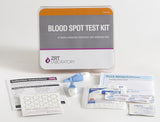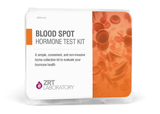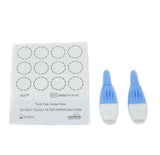Female Hormone Test Panel (PROFILE II) is designed to measure the ten following 13 essential hormones accurately:
1- Estrone Hormone (E1)
2- Estradiol (Estrogen) (E2),
3- Estriol Hormone (E3),
4- Progesterone (Pg),
5- Testosterone (T),
6- DHEA-S (DS),
7- Sex Hormone Binding Globulin (SHBG),
8- Cortisol (C),
9- Thyroid Stimulating Hormone (TSH),
10- Free Triiodothyronine (fT3),
11- Free Thyroxine (fT4),
12- Thyroid Peroxidase Antibody (TPOab).
13- Sex Hormone Binding Globulin (SHBG)
Test Result: You will receive your test result 3-5 working days after the laboratory receives your sample. You will see your hormone levels in graphics and numbers on your test results. You will also see laboratory comments by Hormone Specialist PhD Dr in the comments: you will find Dr analysis of your hormone levels and what to do next.
- Collect samples from the comfort of your home and post them to our lab.
- The test must be used within 12 months after the purchase date.
- The test kit includes a laboratory fee: no additional laboratory cost and tax.
- Customers are responsible for shipping their samples to the laboratory.
- Click the link to see the Sample Test Result Report in Blood Spot
Having too much or too little of a particular hormone in the body can cause hormonal imbalance. This test can uncover whether you are expediting a hormonal imbalance that could be affecting your fertility. This test also allows you to track your hormone levels to understand how they change over time. Tracking your hormone levels over time can also tell you whether your hormone levels are decreasing with age.
Symptoms related to Hormonal Imbalance in Women include:
- Burned Out Feeling
- Hot Flashes
- Decreased Sweating
- Cold Body Temperature,
- Decreased Stamina
- Decreased Flexibility
- Slow Pulse Rate
- Memory Lapses
- Sleep Disturbances
- Poor Concentration
- Dizzy spells
- Mood Swings
- Decreased Mental Sharpness
- Nervous
- Headaches
- Depressed
- Apathy
- Anxious
- Stress
- Aggressive Behaviours
- Irritable
- Difficulty Sleeping
- Mental Fatigue
- Morning Fatigue
- Increased Forgetfulness
- Evening Fatigue
- Tearful
- Allergies
- Sensitivity to Chemicals
- Elevated Triglyceride
- Breast Cancer
- Fibrocystic Breasts
- Decreased Urine Flow,
- Increased Urinary Urges
- Incontinence
- Bone Loss
- Decreased Muscle Size
- Swelling or Puffy Eyes/face
- Nails Breaking or Brittle
- Rapid Heartbeat
- Low Blood Sugar
- High / Low Blood Pressure
- Heart Palpitations
- High Cholesterol
- Loss Scalp Hair
- Oily Skin or Hair
- Increase Facial or Body Hair
- Acne
- Thinning skin
Estradiol (Estrogen) and progesterone hormone imbalance:
Levels and their ratio are an index of estrogen/progesterone balance. An excess of estradiol, relative to progesterone, can explain many symptoms in reproductive-age women, including endometrial hyperplasia, pre-menstrual syndrome, fibrocystic breasts, and uterine fibroids. In older women using estrogen supplements alone, a progesterone deficiency can also result in estrogen dominance symptoms, including weight gain in the hips and thighs, fibrocystic and tender breasts, uterine fibroids, irritability, water retention, and thyroid problems. These symptoms are also seen in some women approaching menopause, whose estrogen levels swing wildly from high to low without the balancing effects of progesterone. If estrogen dominance is not corrected, it can lead to cancers of the uterus and breasts and insulin resistance. With the onset of menopause, when ovarian estrogen and progesterone production declines, a new subset of symptoms can result from low estradiol levels, including hot flashes, night sweats, vaginal dryness, sleep disturbances, foggy thinking, more rapid skin ageing, and bone loss. Therefore, maintaining appropriate estradiol levels, adequately balanced with progesterone, at any age is essential for optimal health.
Testosterone and Sex Hormone Binding Globulin (SHBG) hormone imbalance:
Testosterone levels can also be either too high or too low. Testosterone in excess, often caused by ovarian cysts, leads to conditions such as excessive facial and body hair, acne, and oily skin and hair. Polycystic ovarian syndrome (PCOS) is thought to be caused, in part, by insulin resistance. On the other hand, too little testosterone is often caused by excessive stress, medications, contraceptives, and surgical removal of the ovaries. This leads to symptoms of androgen deficiency, including loss of libido, thinning skin, vaginal dryness, loss of bone and muscle mass, depression, and memory lapses. SHBG is a protein produced by the liver in response to exposure to any estrogen, whether produced naturally by the body, consumed as a synthetic oral contraceptive estrogen, estrogen therapy, or as foods or herbs (phytoestrogens). Released from the liver into the bloodstream, SHBG binds tightly to circulating estradiol and testosterone, preventing their rapid metabolism and clearance and limiting their bioavailability to tissues. SHBG gives a good index of the extent of the body’s exposure to estrogens. The SHBG level is also used to calculate free (unbound) testosterone levels when blood spot is used instead of saliva to measure sex hormones.
DHEA Hormone Imbalance:
Mostly found in the circulation in its conjugated form, DHEA sulfate (DHEA-S) is a hormone produced by the adrenal glands, and levels generally reflect adrenal gland function. It is a precursor for the production of estrogens and testosterone and is, therefore, normally present in more significant quantities than all the other steroid hormones. Its production is highest in the late teens to early 20s and declines gradually with age. Like cortisol, it is involved with immune function, and a balance between the two is essential. Low DHEA can result in reduced libido and general malaise, while high DHEA can have masculinizing effects on women because it metabolizes androgens, including testosterone. Because of its conversion to estrogens and androgens, it is important to monitor levels of these hormones, as well as levels of DHEA, during supplementation.
Cortisol hormonal imbalance is an indicator of adrenal function and exposure to stressors. Under normal circumstances, adrenal cortisol production shows a diurnal variation and is highest early in the morning, soon after waking, falling to lower levels in the evening. Normal cortisol production shows a healthy ability to respond to stress. Low cortisol levels can indicate adrenal fatigue (a reduced ability to respond to stressors) and leave the body more vulnerable to poor blood sugar regulation and immune system dysfunction. Chronically high cortisol is a consequence of high, constant exposure to stressors, and this has serious implications for long-term health, including an increased risk of cancer, osteoporosis, and possibly Alzheimer’s disease.
Free T4, free T3, TSH, and TPO hormone imbalance tests can indicate the presence of an imbalance in thyroid function, which can cause a wide variety of symptoms, including feeling cold all the time, low stamina, fatigue (particularly in the evening), depression, low sex drive, weight gain, and high cholesterol. Thyroid deficiency can also cause infertility, which is why these tests are included in the Female Fertility Profiles.
LH and FSH hormone imbalance tests are included in the Female Fertility Profile to give information on the possible presence of ovarian insufficiency (elevated FSH) or PCOS (elevated LH/FSH).
If you are experiencing any or a combination of those, it’s worth getting your hormone level imbalance checked using our comprehensive ten-panel Blood Spot hormone test.
How to Use










